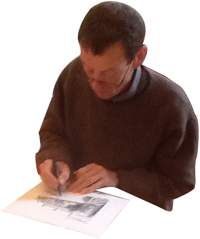
William Hobday
Original Fine Ink Drawings
of Sussex countryside
Home | About Pen and Ink Art | Furniture Restoration
William Hobday, pen and ink artist
Pen & ink drawing is similar to pencil drawing in that the use of line and technique is closely related. It is however a little more difficult to master and is very unforgiving! Mistakes are not easily corrected and this is why the pen and ink technique is usually only taught to or used by older artists. India ink is permanent ink and a mess to clean up, virtually non-erasable and not very forgiving if a spill or mistake happens.However, because of the focus on detail and character, pen & ink drawing can be very rewarding. A good artist can create a range of work from photo-realism to total abstraction and everything else in between. There is a great deal of versatility of pen & ink as an artist media.
William Hobday - pen and ink artist
William Hobday lives in East Sussex where most of his pen and ink fine art is created.William is a self taught artist who specializes in fine pen & ink artwork. William's fine ink art technique is unusual in the amount of detail he includes in each piece of art.
To give an idea of how detailed his pen and ink drawings are, William does not use 'cross hatching', a time-saving method of filling in background or other blank drawing space. Crosshatching is when the pen and ink artist creates the tones by drawing lots of parallel lines, but the technique is often used as a filler.
As William puts it:
"I find my own specialist fine ink drawing technique very effective, because I put in a great deal of detail into each drawing -- but it is also very time consuming!"
William loves to draw landscapes and houses, but he can turn his hand to most subjects, ranging from portraits, wildlife, pets etc.
"As a pen and ink artist, I focus on detail and accuracy and my ultimate aim is to capture the essence, the character of the subject."
William Hobday fine ink artist: what I offer
Contact me for advice and quotes on any pen and ink fine art drawings. I offer:- Original, collectable artwork
- Limited edition prints
- Personal commitment to each client
- Something different, collectable work that will captivate the viewer
- Personal commissions
- Countryside, houses, pets and other animals
There must not be any reproduction without the explicit written permission of the artist. Please contact me as above. I am happy to share my work via approved sources.
The origin of pen and ink fine art
The development of ink truly revolutionized human life. Artists in Egypt, Greece and Asia used ink for creating handwritten manuscripts, religious and political documents and works of art.The development of ink provided people with a permanent means to keep records, create manuscripts and document the world around them.
Ink as a sophisticated artistic medium developed sometime between the 7th and 8th centuries in China, where a range of subjects, from religion, history and daily life, were illustrated using brushes fashioned from animal hair and feathers. Applied to scrolls of paper or sheets of silk, these detailed works of art were forerunners to the approaching development of fine art, pen and ink drawings.
By the Renaissance, new tools were developed to enhance the precision and detail afforded by ink, such as wooden styluses and sharpened metal shards, known as metalpoint. Because of its permanence, ink drawings demanded practice and perfection. For this reason, many artists used this medium for their studies.
Leonard Da Vinci created many detailed studies of human anatomy, mechanical inventions, as well as figure drawings, which exemplify the range of results possible with fine ink drawing. Pen and ink art is used to illustrate the shades, highlights and precision only possible in ink drawings. Ink was also used with other media, such as pencil, graphite, watercolor and chalks, and soon washes and highlighting techniques developed, providing additional effects to ink drawings, whether quick sketches or elaborate compositions.
Other uses of ink
Along with watercolor, ink was one of the mediums used for block printing. Printmaking began through the process of relief, in which a design or image was carved into a surface, and a liquid medium was applied to its raised surface. Then a piece of paper or fabric was positioned on the carving to create a print. Eventually, metal plates joined wooden blocks as carving surfaces, as their metal surfaces offered sharper images. Some artists created numerous prints from the same base. However, many others chose to create single prints of a work.Pen and ink has been used for centuries to create meticulous compositions. In addition, realistic diagrams of the anatomy helped early doctors in the study of the human body.
The printing of books advanced literacy and promoted language arts. As an artistic medium used by masters, such as Rafael, Rembrandt and Picasso, ink is a versatile medium that provides a permanent record of an artistic statement.